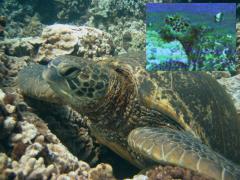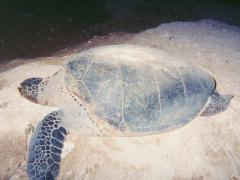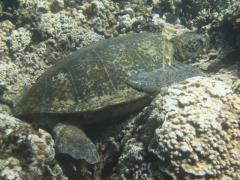Tutu [1990 Turtle 5]
|
|
That was then (inset, 1990) and this is now (2004).
68K JPEG
|
| Quickstats: Seen 1990, 1992, 1993, 1994 (64K JPEG), 1995 (76K JPEG), 1997 (76K JPEG), 1998 (65K JPEG), 1999 (28K JPEG), 2000 (57K JPEG), 2001 (60K JPEG), 2003 (63K JPEG), 2004.
| Summer updates: 1995, 1996, 1997, 1998, 1999, 2000, 2001, 2002, 2003, 2004.
|
We first saw Tutu in 1990. At the time, she was the largest sea turtle we had ever seen. How big was she? She was soooo big, when she landed anywhere she made her own reef. She also looked old, like she'd been around--although in 1990 we had no idea that "been around" meant to the French Frigate Shoals, where she nested, and then back again.
We called her Tutu, the Hawaiian word for "grandmother".
Tutu also sported tags. When she would swim, the metal would catch the sun and their glint was unmistakable. Tutu also had tumors, although we did not know much about them back then. A tumor the size of a golf ball covered her right eye. Her left eye was partially covered, and she had a lump on her right flipper as well.
Tutu proved to be a regular presence at the Turtle House in 1990. We did not see her in 1991, but she was back in 1992, and in 1993 we managed to read one of her tags. 1993 also brought another cause for celebration: for whatever reason, Tutu's tumors were regressing. Her left eye had cleared and the right now only showed a trace of white. The tumor on her flipper was now little more than a roughened area of skin.
We did not see her in 1994 until the very last week of our vacation. After an entire summer's absence, she showed up the morning of August 25th, sporting brand new shiny tags! The mystery was solved. She had migrated to the French Frigate Shoals to lay her eggs and made it back in time for us to see her.
We did not have time to read her new tags but we do know neither of her eyes now shows evidence of tumors. Both her eyes are clear and that was cause for more celebration. Tutu is the first and only Honokowai turtle to have developed tumors and then recovered--at least for now.
Tutu didn't keep up guessing in the Summer of 1995. We sighted her on our second dive. For whatever reason, she accepted us this summer and allowed us to get excellent photos of her. She is our Grand Dame--the oldest of our females--with tags going back to 1990.
Just as important, she has remained free of the tumors she had in 1990 when we first saw her. Tutu is our only case of complete regression. Both her eyes remain clear and the lump on her right flipper is no longer visible. She is tumor free.
On July 15th, we managed to read her tags. She is turtle U 521 (left rear tag).
Typically we see Tutu very early in the dive season, and we see her almost every day at the Turtle House during July and August. After almost 20 dives in 1996, she still hadn't shown, so we sent email to George Balazs of the National Marine Fisheries Service. We told him that our venerable Grand Dame, Tutu, still hadn't shown up at the Turtle House.
On July 10th, we received this email message regarding Tutu, tag number U 521. George wrote:
"Yep. Was was/is up there. Nesting away on East Is. (as most good Hawaiian turtles do). She was seen there by my people in June. Our monitoring period is over so no one up there now (left to the peace of the turtles, seals and birds)."
Then George gave us an interesting piece of news regarding Tutu:
"there is a nice fresh 'J329,' hilited with white paint, on the right posterior part of carapace. Maybe she'll return before you leave."
In 1994, when Tutu last nested, we first sighted her in Honokowai on the morning of August 25th. In 1996, we did our last dive on August 26, and we still hadn't sighted her. We are confident, however, that we'll see her in 1997. U 521 is a Maui girl.
We wish to thank George Balazs and the French Frigate Shoal people for informing us about Tutu's status and for her new paint job.
It certainly did not take long to sight Tutu. We logged her in as 1997 Turtle #4 - fourth turtle sighted for the season. Since we first met her in 1990, Tutu has been "absent" for three summers--1991, 1994 and 1996.
Thanks to George Balazs (National Marine Fisheries Service in Honolulu) we know she was nesting at the French Frigate Shoals all three of those years. What we also know is Tutu returned to her home foraging site of Honokowai, West Maui, as soon as she was done nesting.
Tutu is living proof that females return to very specific home foraging grounds and make fantastic migrations every 2 to 3 years.
Tutu is remarkable and unique in one other way. She had fibropapilloma tumors in 1990 when we first met her and over a period of five seasons, her condition improved steadily. By 1995, there was really no external evidence that she was once stricken with the disease.
When we first met her in 1997, although she hadn't seen us since August 1995, it appeared that she still remembered us. She accepted our approach and allowed us to get close enough to see she was indeed still healthy. She looked back at us through clear and calm eyes.
Try as we could, we could find no evidence of the "J329" the good hearts at the Shoals had painted in white during her 1996 nesting season.
Tutu makes us smile. For 1997, she was back (again) and still topping our list of regression cases.
In the summer of 1998, we first sighted Tutu resting in a turtle trample at Reef Two, a few kicks down current of East House. We saw our good friend on a July 3rd dive, and she appeared to be continuing her good fortune.
On subsequent dives, however, we noticed she had numerous white blemishes on her neck and shoulders. These were not raised (which would suggest tumors) and even appeared as though they were painted on. They might even mean nothing.
The trouble is that Tutu is a former fibropapilloma (FP) case. She is one of the lucky ones. None of the scientists we've talked to know whether regression (improvement in health) is permanent. That is why we find the white blotches on her neck and shoulder alarming. If our first regression case is now having a setback, what does that imply for all the others?
Although we tried to get close enough to figure out if we were looking at some kind of precursor to FP, neither of us could make any determination. Encouragingly, we both feel almost certain that we are not looking at FP.
We had expected Tutu to migrate to honu nesting grounds at the French Frigate Shoals (FFS) in 1998. Tutu has a typical two-three year reproductive cycle, and her last run to East Island was in 1996. Looking at her nesting record, we feel confident that she will not be at Honokowai for the summer of 1999.
We have requested that Tutu be looked over carefully if she does arrive at the FFS to nest. We'd like to determine exactly what those troubling white blotches are on her, and we also want to know about her skin barnacle condition. Like so many other turtles at Honokowai, Tutu's fleshy rear quarters are ridden with a new type of skin barnacle covering nearly every square centimeter of skin.
Given the longest she's ever been away from nesting at the Shoals is three years, her appearance at Honokowai for 1999 could not be viewed as a good thing.
That's why, as much as we love her, we hope she isn't around our dive site this summer. We very much hope she is laying down eggs at East Island. Nothing would better reassure us that Tutu is healthy and robust.
Seeing the Grand Lady again is always special. This first-time-of-the-season sighting was even more so.
During a rather uneventful dive at Reef 2, Ursula spied a shell resting in a crevice, white letter and numbers glinting in the afternoon sun. She approached, took one look at the turtle, and recognized Tutu.
Delight was mixed with confusion. Throughout the summer we'd asked George Balazs of the US National Marine Fisheries Service if she'd shown up at the French Frigate Shoals, where Hawaiian green sea turtles nest. We were told gently, no, but don't worry, she could have nested on one of the
other islands and escaped notice.
Yet there she was, big as life, with an A142 engraved neatly on her shell--absolute testimony she was a 1999 nester at East Island, French Frigate Shoals.
We emailed this information to George, who was just as happy as we were that she'd put in an appearance. He informed us that she'd last been sighted, probably nesting, on June 23rd. The A142, he explained, was applied on June 8, the first time she'd been seen.
Given the length of time between her last recorded sighting at the FFS
and her appearance at Honokowai, we suspect that she might have nested at least one more time before heading home.
Best of all, those 1998 white neck and shoulder blemishes are gone, and we can now answer the question, "Is regression permanent?"
It is for another year...
We fully xpected to see Tutu this summer and she didn't disappoint. Sure enough, we sighted her--fat, regal, and content--at one of her favourite haunts at Reef 2.
To our delight Tutu looked healthy, and her regression status has held for yet another year. Tutu had FP when we first sighted her in 1990 and was the first of the Honokowai turtles to recover from this disase. Her regression is now into its eighth year.
She spent considerable time simply resting and doing what large adult honu do during most summer days. We respected her preference for privacy, so most of the time when we sighted her we simply waved and continued on our way.
Tutu provided us with wonderful memories this summer. She was Maid of Honour at our Renewal of Vows ceremony this summer. Usually, though, she was just this friendly face we've known since 1990--and what with this being 2000, we and Tutu have aged a decade "together."
Reviewing video from 1990 and comparing that to now confirms one thing. Time has certainly treated Tutu better than it's treated us. Maybe that's because turtles don't get gray hair and wrinkles!
Well, Tutu didn't make us wait long to say hello for Summer 2001. We sighted her on July 5th on our first dive. She was cool, calm and approachable and acted like no time had gone by since last we met. In fact, we sighted her at Reef 2, the same place we last saw her a year before.
In some respects we were surprised to see her. We thought she might make a migration run to the French Frigate Shoals--something she's been doing every two or three summers since 1988. Make no mistake, though, it was nice to have Tutu around for the entire summer.
She is our Grande Dame.
Since Kaula hasn't been sighted for another year, Tutu now shares the claim for the longest residency time at Honokowai with our good friend Nui. We have known Tutu since 1990, when she had fibropapilloma. Now a regression case, Tutu is our oldest female.
Tutu spent all her summer at Reef 2 and it was a rare dive where she wasn't at one of her favourite haunts. She's been packing on the pounds and we don't expect to see her in Summer 2002. She'll likely be nesting at East Island instead.
Still, if we're lucky, we might be around to see her return in late August 2002. We're keeping our fingers crossed.
As expected, Tutu was off to the French Frigate Shoals this summer. On August 4, 2002, George Balazs sent us email confirming that Tutu was performing her motherly duties at East Island. This year, however, the East Island monitoring team (a collaboration of the US NMFS and F&WS) managed to get her portrait while she was making one of her nests.
Tutu, the Grand Dame of Honokowai, nesting at East Island.
48K JPEG
Photo by Aron Dietrich and Erin Green
|
|
Well, it didn't take long for us to resight Tutu. She was the fourth turtle we saw on our first dive of the summer. We found her resting peacefully at Reef 2. She accepted our presence calmly even though almost two years had passed since we last met. A quick look-over showed she was in excellent health--quite portly, and regression still holding.
Tutu had fibropapilloma tumours when we first saw her back in 1990. Her tumours were much improved in 1992 and that made Tutu our first regression case. She taught us that green sea turtles can survive FP.
We were blessed having The Grande Dame around this summer. Tutu really doesn't do much--just rests on the bottom, with infrequent trips up to the surface for air. Then again, she doesn't have to do anything to keep our affections.
Tutu is one of our Old Ones. She has lived at Honokowai now for at least 14 summers. She's testimony to the strong site fidelity of honu to their home reefs.
We weren't sure we'd see Tutu in 2004. We'd heard from George Balazs that she had been recorded nesting at the French Frigate Shoals, so we knew she had gotten there safely. The question was, would she get home before our diving was over for the summer?
To our great joy, the answer to that turned out to be yes. On August 14, Ursula spotted a female at the foraging site with an engraved number on the shell. Although she read only the first two digits, "27", they turned out to be enough. It took a couple of days, but we eventually tracked down George's email in which he noted that Tutu would be carrying the number 278 this year. We'd been diving at our alternate site, but this revelation got us back into the water at Reef 2. Sure enough, exactly in her old resting spot, there was Tutu!
|
|
Tutu occupies her regular spot on the reef, clearly displaying the number 278 engraved on her shell.
72K JPEG
|
There is always rejoicing when we see that one of our nesting females has returned unharmed. Tutu, however, is special because we've known her since 1990. In a summer like 2004, when so many of our regulars went missing, it was reassuring to have Tutu back where we feel she belongs.
Last modified 04/09/25
Send comments or corrections to bunrab@io.org

andfriendt.jpg)

